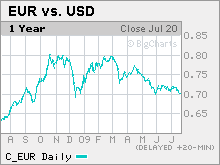Dollar hits 7-week low versus basket
Greenback loses its safe haven appeal as stocks churn and data shows an increase in U.S. home prices.
LONDON (Reuters) -- The dollar hit a seven-week low versus a basket of currencies Wednesday as steady stock markets and data showing stronger U.S. home prices offset weak bank earnings, denting the greenback's safe-haven allure.
U.S. stocks seesawed with the Nasdaq gaining for its 11th straight session, buoyed by solid profits from Apple Inc (AAPL, Fortune 500). European shares also closed higher for the eighth straight session.
"We've seen the stock markets grind higher ... and that has helped currencies gain a bit of a bid against the U.S. dollar," said Sacha Tihanyi, currency strategist at Scotia Capital in Toronto.
Trading was choppy and lacked conviction, with some equities indexes and currencies testing key technical levels, analysts said. Investors awaited more news on the economy and corporate earnings to see whether the recent rally in risk appetite can be sustained.
In late New York trading, the ICE Futures' dollar index , a measure of the greenback's value against six major currencies, fell 0.3% on the day to 78.728. It had earlier hit 78.563, the lowest level since early June.
Kathy Lien, director of currency research at GFT Forex in New York, said solid housing data and comments from Federal Reserve Chairman Ben Bernanke that he was seeing some positive signs in the housing market also helped boost risk appetite and push the dollar lower.
"Even though Bernanke repeated the same remarks he made on Tuesday, markets are encouraged by his comments today that the recovery is gaining steam," she said.
Data from the Federal Housing Finance Agency earlier showed prices of U.S. single-family homes rose by a seasonally adjusted 0.9% in May from April.
The euro was up slightly at $1.4220, near a more than six-week high of $1.4277 hit on Tuesday.
The dollar fell 0.2% to ¥93.47, while the euro was down 0.3% at ¥132.88.
Risk appetite had improved in recent recessions, fueled by strong quarterly results from some of the big banks including Goldman Sachs (GS, Fortune 500), but that optimism has started to wane, analysts said.
Worries about the financial sector resurfaced following a third consecutive quarterly loss at Morgan Stanley (MS, Fortune 500), along with rising credit losses at Wells Fargo & Co. (WFC, Fortune 500) and a 43% drop in profits at Bank of New York Mellon (BK, Fortune 500).
"Over the past 48 hours ... the markets have pulled back from the really strong drive that they were building into last week," John Kicklighter, currency strategist at DailyFX.com in New York.
"So many markets are actually coming up to significant resistance in terms of risk appetite," he said. The markets are starting to realize that "the earnings quality is perhaps not as good as many analysts and speculators are actually expecting."
In other currencies, sterling erased losses after minutes from the Bank of England's latest policy meeting showed a unanimous decision to maintain the bank's 125 billion pound asset-buying total and keep interest rates at 0.5%.
The market took this as a signal that UK quantitative easing could be at or near an end, suggesting the economy may be starting to recover. Sterling last traded up 0.2% at $1.6471.
Among higher-risk currencies, the New Zealand dollar rose 0.5% to US$0.6589 while the Australian dollar rebounded from lows to trade at US$0.8164, down 0.2% on the day. ![]()


